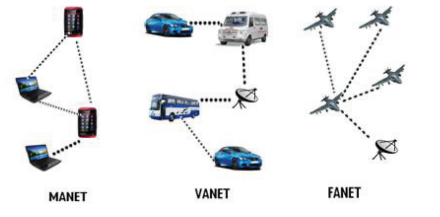Flying Ad Hoc Network: A Newest Research Area for Ad Hoc Networks
Objective
The main objective of this project is “To transfer the data and signals between each other without any human experts and without any physical connectivity between the nodes.”
Abstract
FANET can be characterized as another type of mobile ad-hoc network wherein, the hubs or nodes are called UAVs. In FANET, UAVs and flying aircraft act as nodes which communicate with each other when they fly in the air without any physical connection. It is the special form of wireless ad hoc network in which nodes fly in the air, and while flying in the air they communicate with each other, transfer the data and signals between each other without any human experts and without any physical connectivity between the nodes. FANET can also be called a subset of VANET, which is also a subset of MANET. We have proposed Flying ad-hoc network architecture along with its usages, characteristics, advantages, routing protocols and mobility models.
Keywords: FANET, UAVs, VANET, MANET, Research Issues.
NOTE: Without the concern of our team, please don't submit to the college. This Abstract varies based on student requirements.
Block Diagram

Specifications
HARDWARE SPECIFICATIONS:
- System: Pentium IV 2.4 GHz.
- Hard Disk: 40 GB.
- Floppy Drive: 1.44 Mb.
- Monitor: 15 VGA Colour.
- Mouse : Logitech.
- Ram: 512 Mb.
SOFTWARE SPECIFICATIONS:
- Operating system: Windows XP/7/LINUX.
- Implementation: NS2
- NS2 Version: NS2.2.34
- Front End: OTCL (Object Oriented Tool Command Language)
- Tool: Fedora (To simulate in Linux OS)
Learning Outcomes
- What is Unmanned Aerial Vehicle?
- Difference between FANET, MANET, VANET.
- What is ad-hoc network?
- Routing in FANET.
- Properties of Ad-Hoc Routing Protocols.
- What is Tomcat server and how they can work?
- What type of technology versions is used?
- Data Parsing Front-End to Back-End.
- Need of Eclipse-IDE to develop a web application.
- Working Procedure.
- Testing Techniques.
- Error Correction mechanisms.
- How to run and deploy the applications?
- Introduction to basic technologies used for.
- How project works?
- Input and Output modules.
- How to test the project based on user inputs and observe the output?
- Practical exposure to software tools and solution providing for real time problems working with team/ individual work on Creative ideas.
- Learn about types of algorithms and how to use?
- Project Development Skills:
- Problem analyzing skills.
- Problem solving skills.
- Creativity and imaginary skills.
- Programming skills.
- Deployment.
- Testing skills.
- Debugging skills.
- Project presentation skills.
- Thesis writing skills.





 Paper Publishing
Paper Publishing
